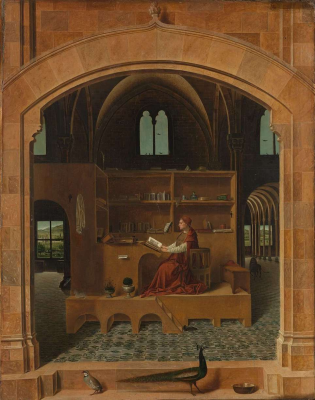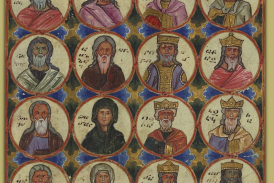Gospel in Art: Feast of Saint Jerome

St Jerome in his Study, by Antonello da Messina © National Gallery, London
Source: Christian Art
Gospel of 30 September 2024
Matthew 13:47-52
Jesus said to the crowds: 'The kingdom of heaven is like a dragnet cast into the sea that brings in a haul of all kinds. When it is full, the fishermen haul it ashore; then, sitting down, they collect the good ones in a basket and throw away those that are no use. This is how it will be at the end of time: the angels will appear and separate the wicked from the just to throw them into the blazing furnace where there will be weeping and grinding of teeth.
'Have you understood all this?' They said, 'Yes.' And he said to them, 'Well then, every scribe who becomes a disciple of the kingdom of heaven is like a householder who brings out from his storeroom things both new and old.'
Reflection on the painting
Today we celebrate the feast of Saint Jerome (c. 347-420 AD). He is mainly known for his pivotal work in translating the Bible into Latin, producing what is known as the Vulgate. This translation became the standard version of the Bible for the Western Church for centuries, profoundly shaping Christian liturgy, theology, and scholarship. Jerome's mastery of Latin, Greek, and Hebrew allowed him to work directly from original biblical texts, which was a rare scholarly achievement in his time. Commissioned by Pope Damasus I, Jerome began translating the Gospels in 382 AD. His efforts aimed to create a more accurate and readable version of the Scriptures, bridging the linguistic and cultural gap between the ancient texts and the Latin-speaking Christian world.
Saint Jerome in the arts is typically depicted in two different settings: either as a scholarly figure in his study, or as a hermit in the desert. In the first, he is shown seated at a desk, surrounded by books, manuscripts, and writing tools, symbolising his immense intellectual contributions, particularly his Latin translation of the Bible. The second depiction places Jerome in a desert setting, reflecting his ascetic lifestyle and retreat into solitude. Here, he is often shown wearing simple, tattered garments, sometimes striking his chest with a rock, symbolising his penitential practices. Both images highlight his unique role as a scholar-monk: one focuses on his intellectual labor in the service of the Church, while the other underscores his spiritual isolation and rigorous self-discipline.
Antonello da Messina's St Jerome in His Study, painted around 1475, is a masterpiece of Italian Renaissance art. The painting presents Jerome seated at his desk within a grand, detailed architectural interior (note the fine detail of the tiled floor). The study is meticulously depicted with a blend of Gothic and Renaissance elements, emphasising Jerome's role as a scholar. Surrounded by books, manuscripts, and natural objects, Jerome is immersed in his work, symbolising his immense contribution to biblical scholarship and translation. The use of perspective draws the viewer's eye towards the saint, framed by an arch that accentuates the scholarly serenity of the scene. The large arches function almost as architectural halos around the saint.
A ledge separates the viewer from Saint Jerome, providing a visible boundary between the real and the painted world. It is guarded by two birds: a partridge, which symbolises truth (it was thought that a partridge always recognised its mother's call) and a peacock (symbolising immortality - their flesh was thought never to decay).
LINKS
Gospel in Art: https://christian.art/
Today's Reflection: https://christian.art/daily-gospel-reading/matthew-13-47-52-2024/


















